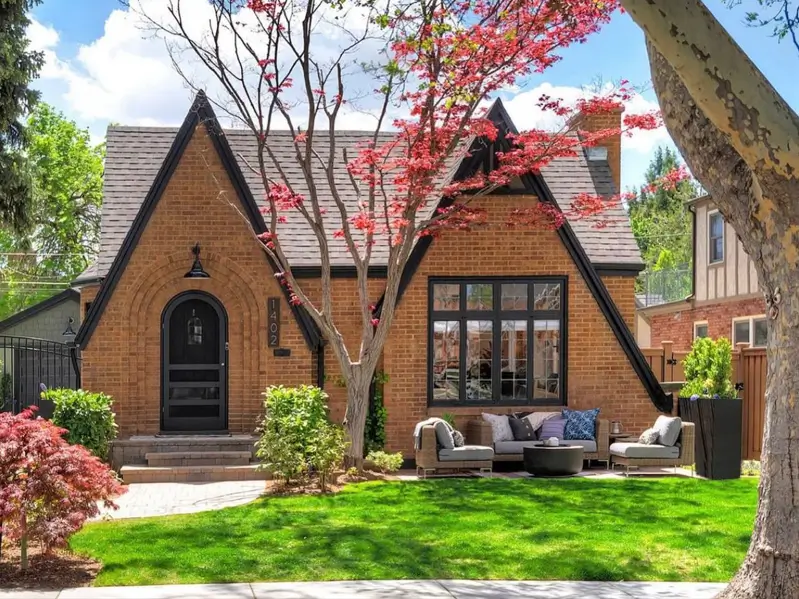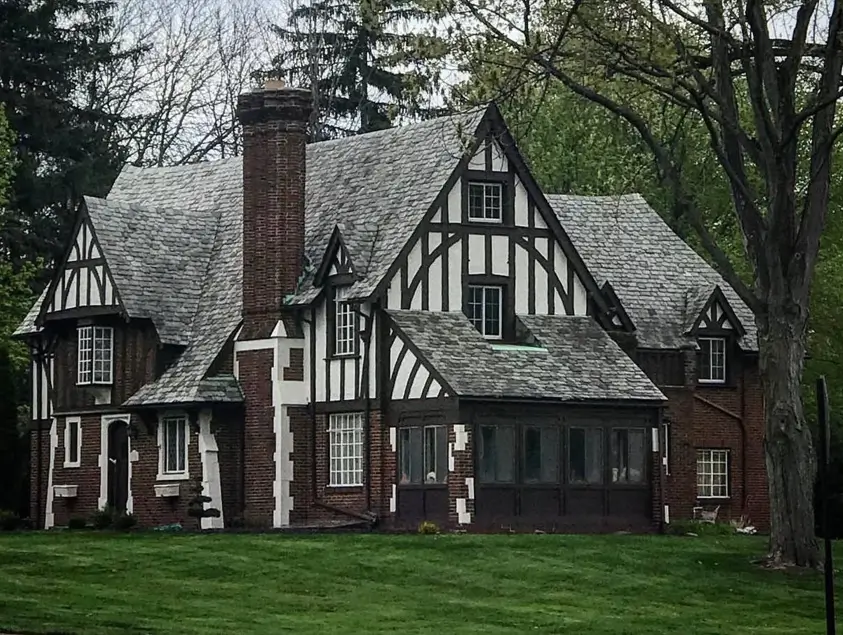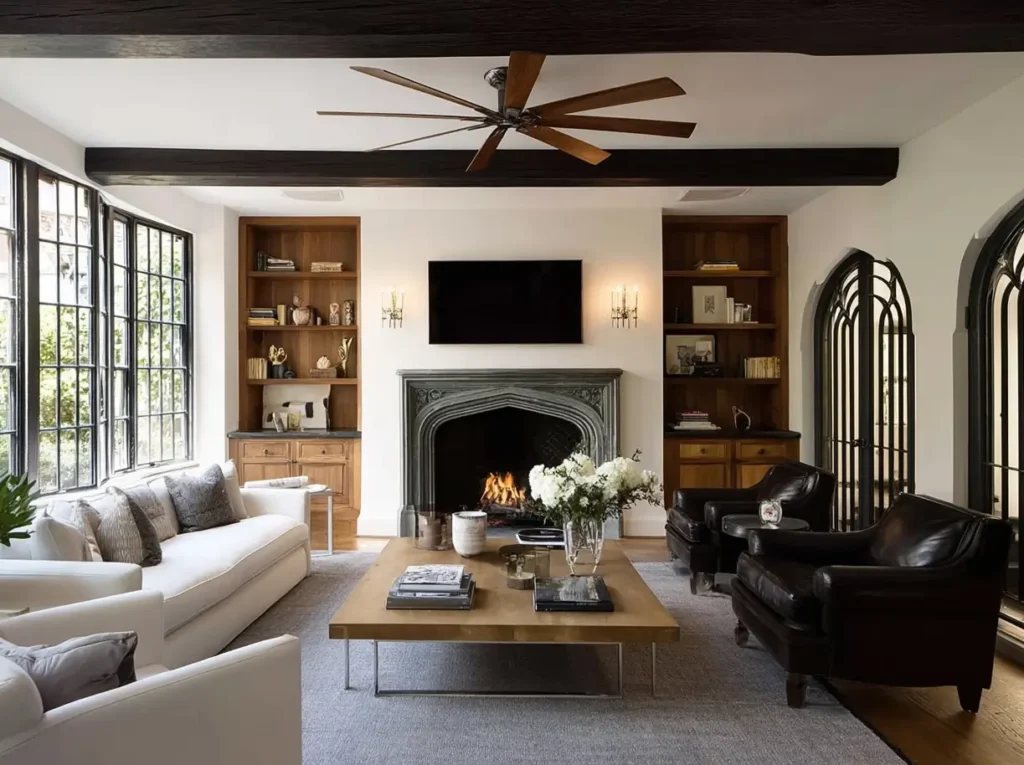The small Tudor-style house instantly evokes images of storybook charm and enduring romance. With their distinctive half-timbering and fairytale rooflines, these homes possess a unique character that feels both historic and deeply personal. Far from being confined to the past, this captivating architectural style offers a perfect canvas for contemporary living.
Whether you’re looking to restore classic details or create a small modern Tudor-style house with a bold, new personality, the possibilities are endless.
This curated collection highlights everything from classic cottages defined by rustic stone and timber to modern interpretations reimagined with moody monochromatic palettes. You’ll discover how simple changes to color, materials, and landscaping can dramatically enhance your small Tudor home’s storybook charm and curb appeal.
The Defining Characteristics of Tudor Revival Architecture
Before exploring the visual inspiration, it’s helpful to understand the architectural details that give a Tudor home its signature look. These core elements of Tudor revival architecture are the building blocks that work together to create the style’s enduring appeal.
- Steeply Pitched Roof: Often the most recognizable feature, these roofs typically have multiple, overlapping gables of varying heights, creating a dramatic and picturesque silhouette.
- Decorative Half-Timbering: This is the classic exposed wood framework on the upper story, with the spaces between the timbers filled with stucco or brick.
- Prominent Chimneys: Tudor homes often feature massive, ornate chimneys, frequently capped with decorative chimney pots, anchoring the home and emphasizing the hearth.
- Rich Exterior Materials: The style is distinguished by a mix of natural textures, most commonly brick on the first story and stucco or stone on the second.
- Tall, Narrow Windows: Windows are typically grouped together in sets of three or more and often feature diamond-paned or leaded glass.
47 Inspiring Exterior Ideas for a Small Tudor-Style House
1. Layer Rich Textures
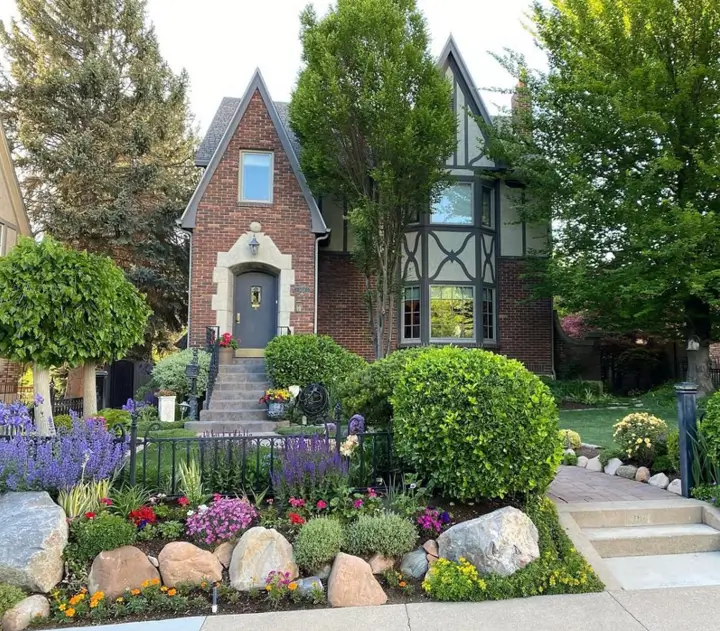
The robust texture of red brick grounds this home, creating a beautiful contrast with the decorative half-timbering above. It’s a classic Tudor pairing that always delivers on charm. The arched stone surround adds weight and importance to the entry, making it a clear focal point.
Design Tip: Experience shows that lush, multi-layered plantings are the most effective way to soften a Tudor’s strong architectural lines and connect it to the landscape.
2. Use a Bold, Colorful Entry
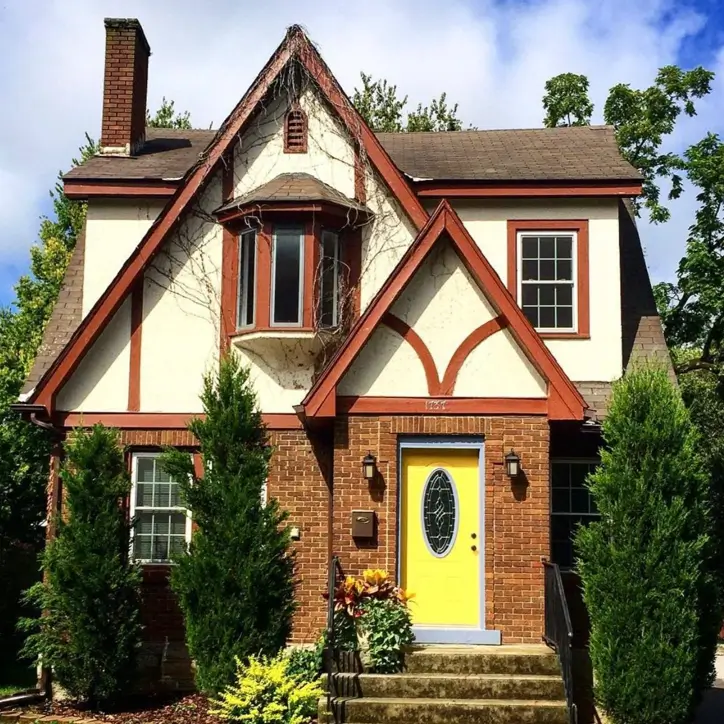
Vibrant yellow on the front door offers an unexpected, contemporary twist to this home’s classic brick and stucco facade. The decision to paint the decorative timbering in a warm red harmonizes with the brick below, creating a cohesive and thoughtfully designed exterior.
Design Tip: The front door is always the best place to experiment with color. It’s a relatively small change that makes a huge impact and an easy way to infuse personality right at the entrance of your small Tudor home.
3. Frame the Entry in Brick
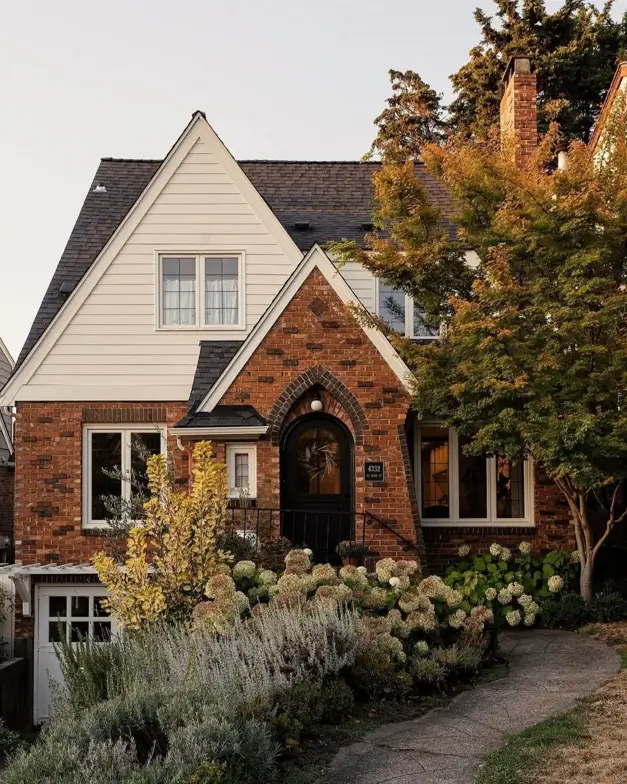
A dramatic brick archway beautifully frames the entrance, creating a powerful focal point that is quintessentially Tudor. Opting for clean, white siding on the upper level offers a crisp contrast to the textured brick below, subtly updating the home’s character while respecting its origins.
Design Tip: When a home has a strong architectural feature like this arch, the best results come from letting it command attention. A dark, understated front door enhances the sense of depth rather than competing with the brickwork.
4. Pair Stone and Stucco
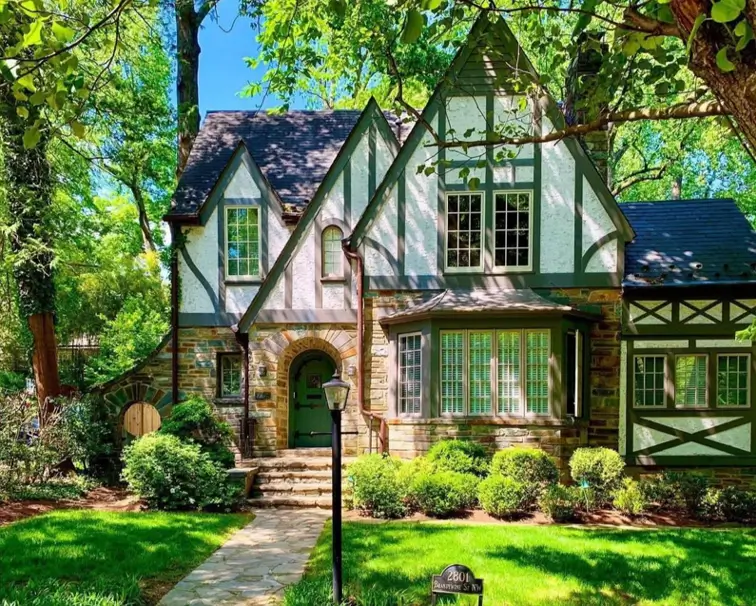
Rough-hewn stone across the ground floor provides a rustic, grounding element that connects the house to its landscape. Above, the classic stucco and timbering are softened by using a muted, earthy green for the trim, a sophisticated choice that pulls from the surrounding foliage.
Design Tip: Instead of defaulting to high-contrast trim, look to the natural elements of the property—like tones in the stonework or surrounding trees—to create a more cohesive and organic color scheme for a small modern Tudor-style house.
5. Define Character with Leaded Glass
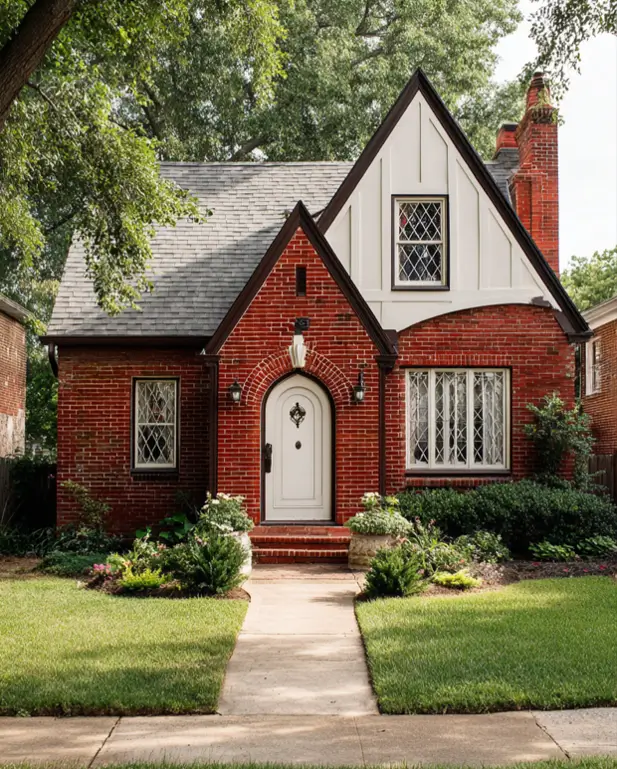
Diamond-pane windows are a quintessential feature that instantly signals Tudor character. Here, the crisp white of the arched door and the simple vertical siding in the gable provide a clean, bright contrast to the rich, textured red brick that envelops the majority of the home.
Design Tip: With beautifully detailed windows like these, keeping the surrounding trim and color palette simple is a proven approach. A clean white or soft cream allows the intricate glasswork to stand out.
6. Frame with Living Greenery
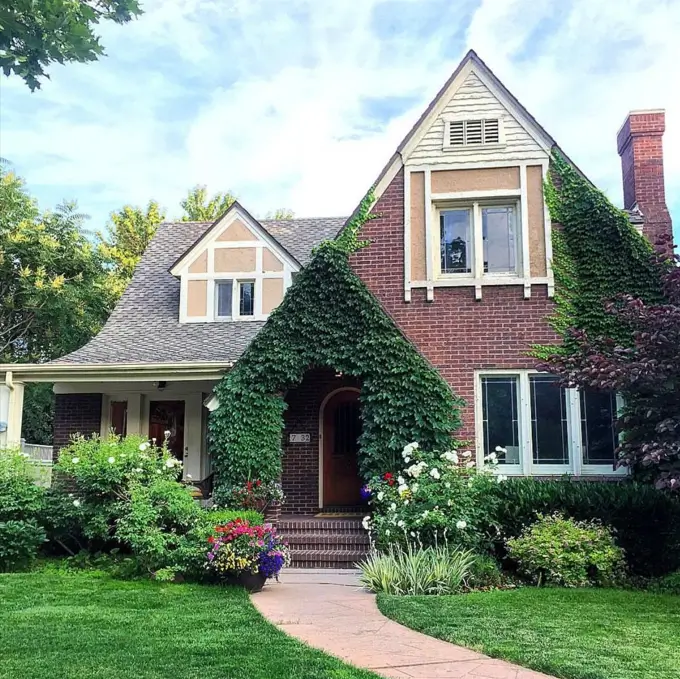
Climbing ivy forms a breathtaking natural arch over the doorway, beautifully softening the home’s brick facade and enhancing its storybook quality. This living element integrates the house with its lush garden, creating a seamless transition from the curated landscape to the structure itself.
Design Tip: While visually stunning, a common challenge with climbing vines is their potential to damage mortar. The most successful long-term applications involve choosing less aggressive varieties and committing to regular pruning.
7. Go Boldly Monochromatic
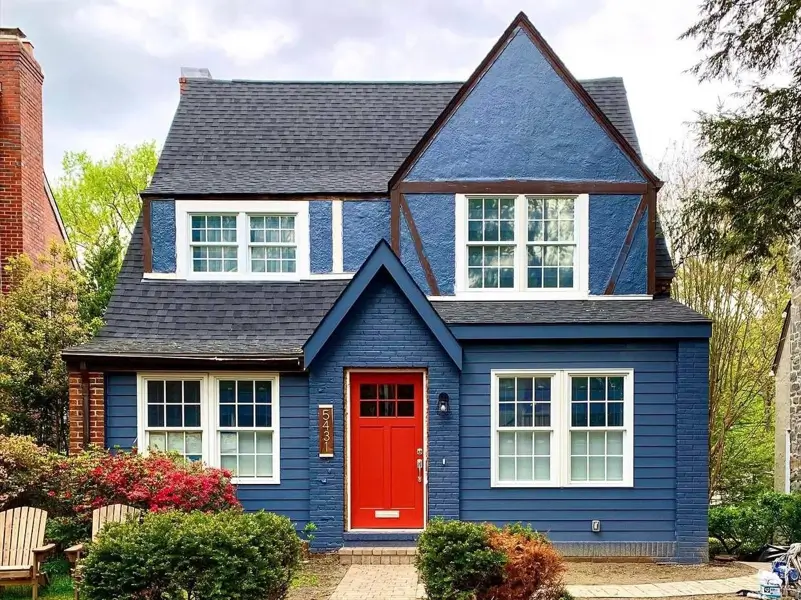
A deep, saturated blue completely reimagines this small modern Tudor-style house, giving it a distinctly contemporary edge. Unifying the different exterior textures with a single, dramatic color simplifies the form and makes a powerful statement. The crisp white trim and a punchy red door create a striking graphic contrast.
Design Tip: A monochromatic scheme can instantly update an older structure. The key to making it work is maintaining balance—bright white windows keep the look fresh and prevent the deep blue from feeling too heavy.
8. Modernize with a White Facade
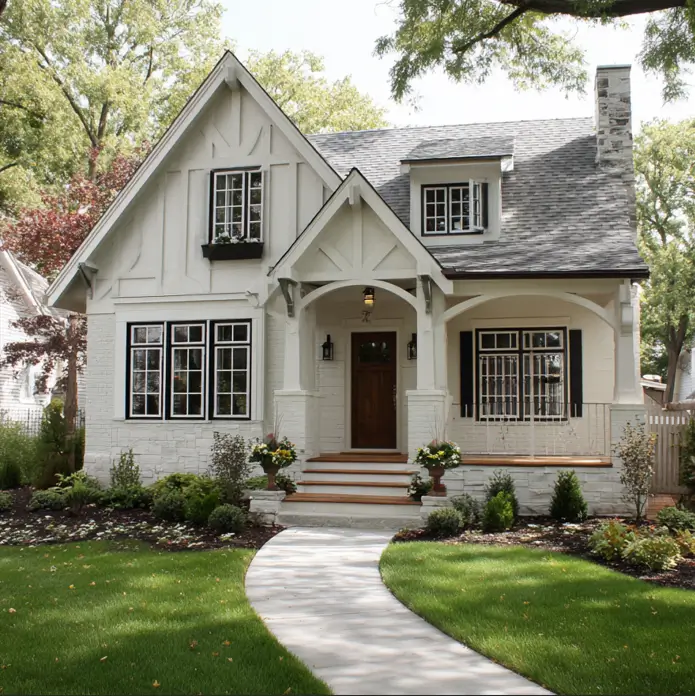
Painting the entire exterior, including the brick, a brilliant white instantly gives this small modern Tudor-style house a farmhouse-inspired feel. Sharp black trim provides a graphic punch and defines the windows, while the warm wood of the front door offers an inviting, organic touch.
Design Tip: When painting exterior brick, the paint’s finish is just as important as the color. For the most durable and authentic look, a high-quality masonry paint in a matte finish maintains the brick’s natural texture.
9. Use a Soothing, Tonal Palette
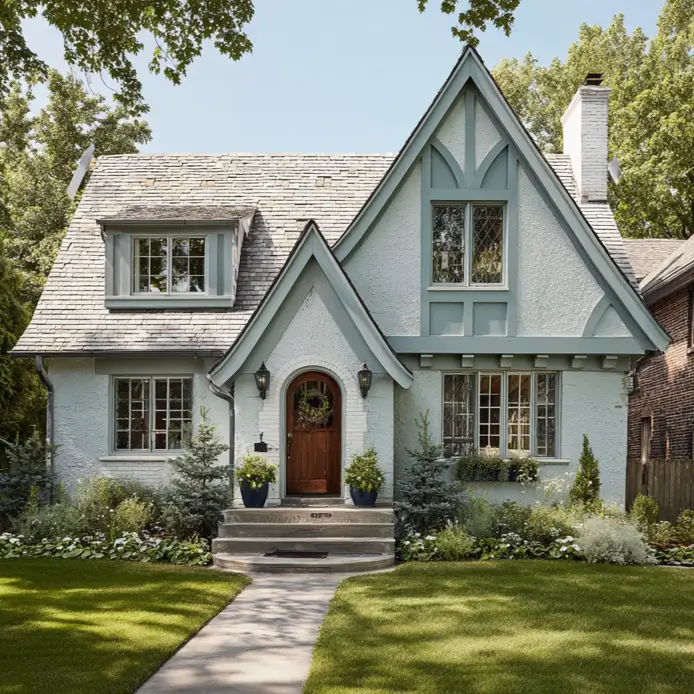
A soft, blue-green hue washes over this stucco exterior, creating a serene and updated feel. Using a slightly deeper shade of the same color for the trim and architectural details achieves a sophisticated, tonal look that feels both custom and calming.
Design Tip: A tonal color scheme is a wonderful way to create an elegant exterior. By minimizing high contrast, the home’s beautiful textures and architectural forms are allowed to become the main focus.
10. Build Charm with Natural Stone
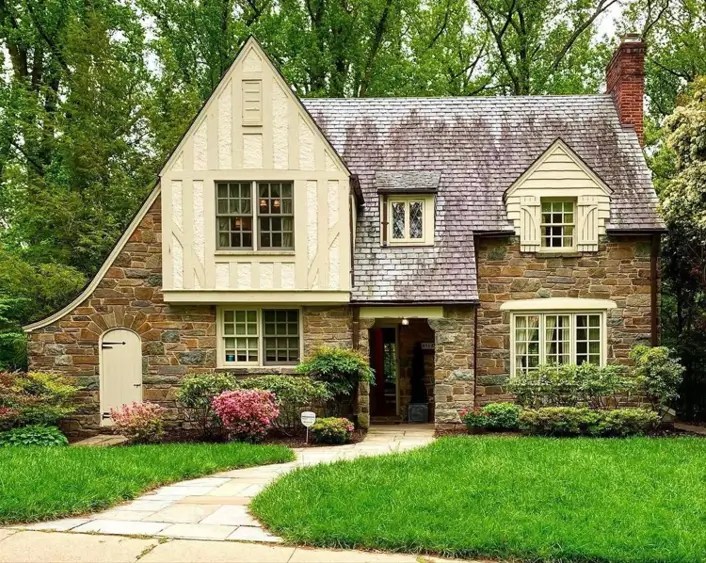
An exterior almost entirely clad in warm, varied stonework gives this home an incredibly grounded, historic feel. The sweeping, asymmetrical roofline and simple cream-colored gable add to its irresistible storybook cottage character.
Design Tip: When working with a heavy material like natural stone, it’s important to balance it with lighter elements. The cream trim and simple gable here prevent the facade from feeling weighed down, keeping the overall look charming and approachable.
11. Try a Crisp, Naval Palette
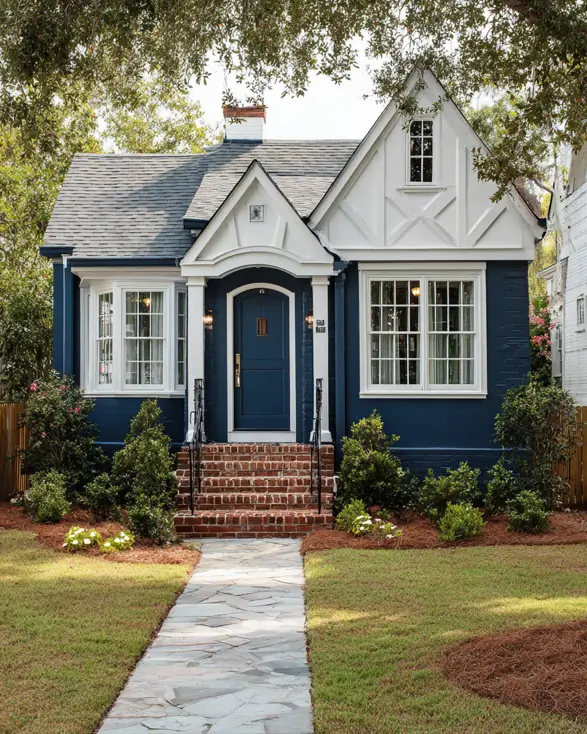
Deep navy blue siding paired with brilliant white trim creates a sharp, contemporary feel for this home. Matching the front door to the primary house color results in a seamless, sophisticated look, allowing the classic brick steps and the white portico to stand out as key features.
Design Tip: For a truly modern take on the Tudor style, painting the front door the same color as the siding creates a sleek, monochromatic effect that feels intentional and high-end.
12. Experiment with Tudor House Colors
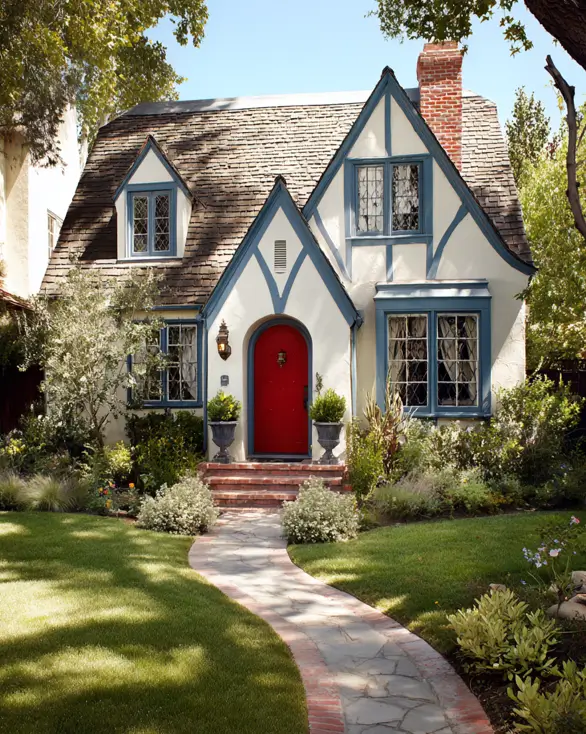
Classic cream-colored stucco provides the perfect neutral canvas for playful color. Dusty blue trim adds a soft, historic feel, while the brilliant red arched door creates a confident and cheerful focal point that feels straight from the pages of a fairytale.
Design Tip: A classic, three-color palette on a storybook home is all about balance. Two colors should complement each other, while the third provides a powerful, singular accent on the front door to draw the eye in.
13. Design a Grand Arched Porch
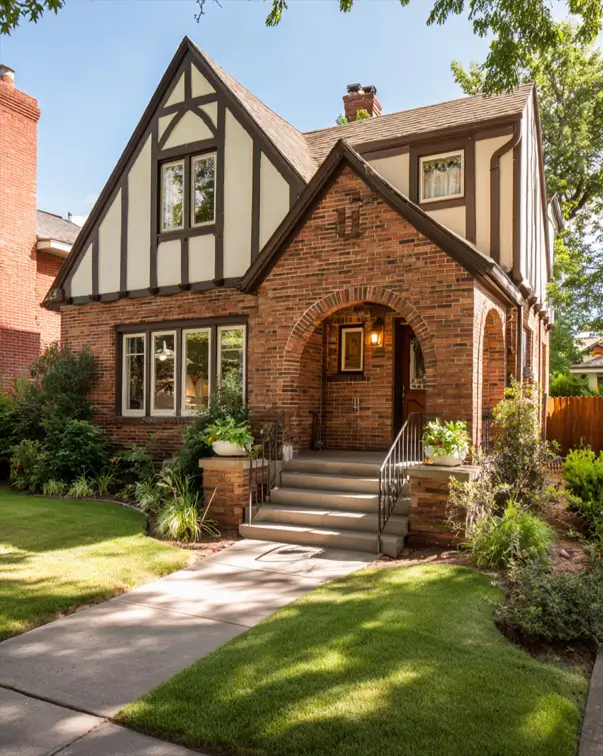
Multiple brick arches form a substantial covered porch, giving the entrance a sense of permanence and grandeur. This design grounds the home, beautifully balancing the lighter half-timbering on the upper level and creating a warm, protected transition.
Design Tip: With a deep, covered entry like this, lighting is crucial. A beautiful hanging lantern or sconce will illuminate the space at night, ensuring safety while casting a welcoming glow that highlights the architectural depth.
14. Add Drama with Gothic Windows
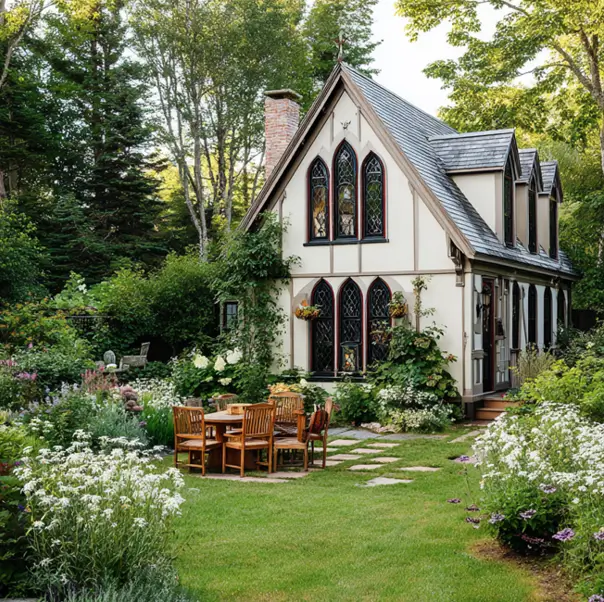
Pointed Gothic arches on the windows lend a romantic, ecclesiastical drama to this cottage. This stunning detail elevates the home from a simple Tudor to a truly unique fairytale escape, especially when set against the backdrop of a wild, enchanting garden.
Design Tip: When a home features such ornate, statement windows, the landscape design often looks best when it feels special but not overly formal. A slightly untamed, cottage-style garden complements the romance of the architecture.
15. Choose a Graphic Black and Cream
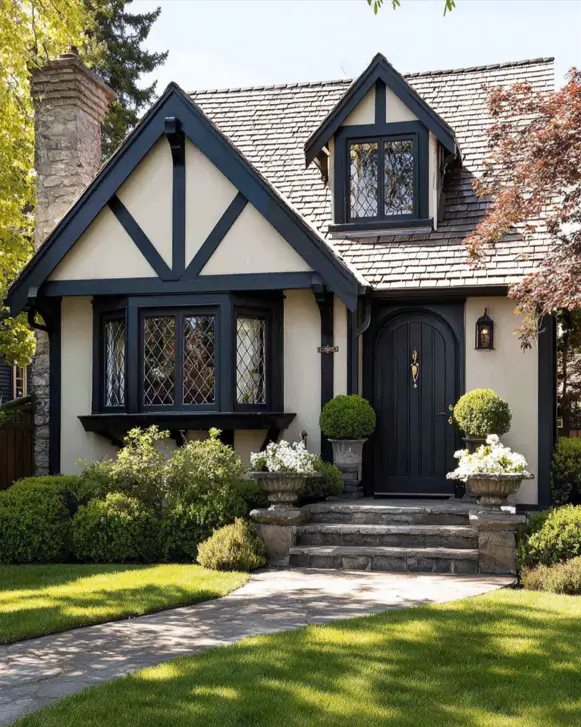
Deep black trim set against a warm, creamy stucco creates a striking and graphic facade for this small Tudor-Style house. This high-contrast choice sharply defines the home’s classic Tudor lines, from the half-timbering to the diamond-pane windows, for a look that is both timeless and impeccably tailored.
Design Tip: When using such a bold, high-contrast palette, consistency is key. Carrying the black through to the front door, window frames, and timbering creates a cohesive, unified design that feels intentional and sophisticated.
16. Emphasize Verticality
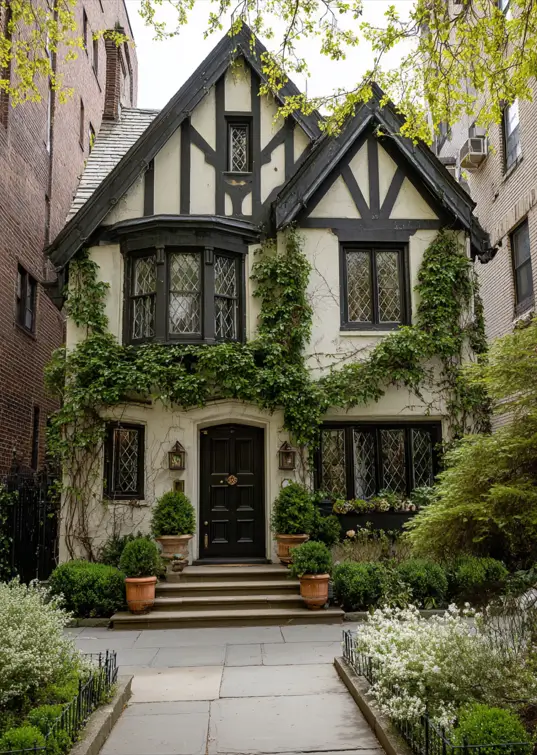
Dark timbering creates a powerful vertical statement against the light stucco, drawing the eye upward. This clever emphasis on height makes the home feel grand and statuesque despite its compact footprint. Climbing vines are used beautifully here to soften the facade’s sharp geometry.
Design Tip: On a narrow lot, accentuating the vertical is a powerful tool. Using high-contrast timbering and encouraging vertical plantings not only adds visual interest but also creates an illusion of greater size and presence.
17. Use a Moody, Monochromatic Blue
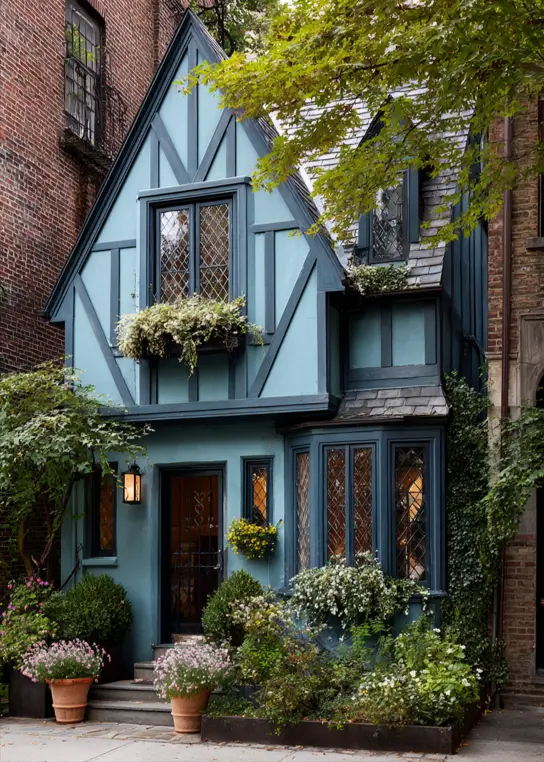
Washing the entire facade in a dusty, muted blue creates an incredibly chic and modern look. This tonal approach, where even the timbering is painted in the same hue, allows the home’s complex architectural forms and intricate diamond-pane windows to truly take center stage.
Design Tip: When going monochromatic, it’s essential to add life back with greenery. The lush window boxes and overflowing pots here provide a necessary organic contrast to the sophisticated single-color palette and prevent the design from feeling flat.
18. Pair Moody Hues with Warm Brick
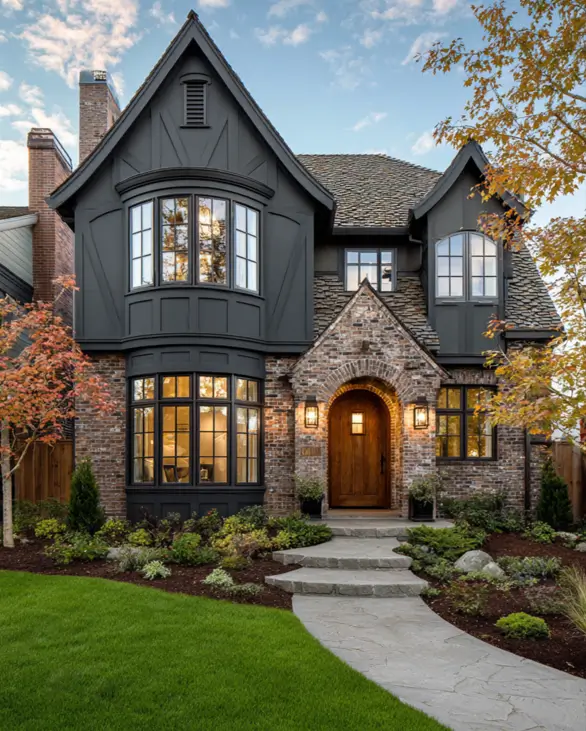
Charcoal-painted siding and trim create a dramatic, modern statement, beautifully contrasted by the earthy texture of the variegated brick below. This combination feels sophisticated and current, while the classic arched entryway and warm wood door provide an essential touch of welcoming warmth.
Design Tip: When embracing a dark, moody exterior, incorporating natural materials is a great way to maintain warmth. The brick and wood here are critical—they prevent the dark charcoal from feeling cold and instead make the design feel rich and layered.
19. Show Personality with Color
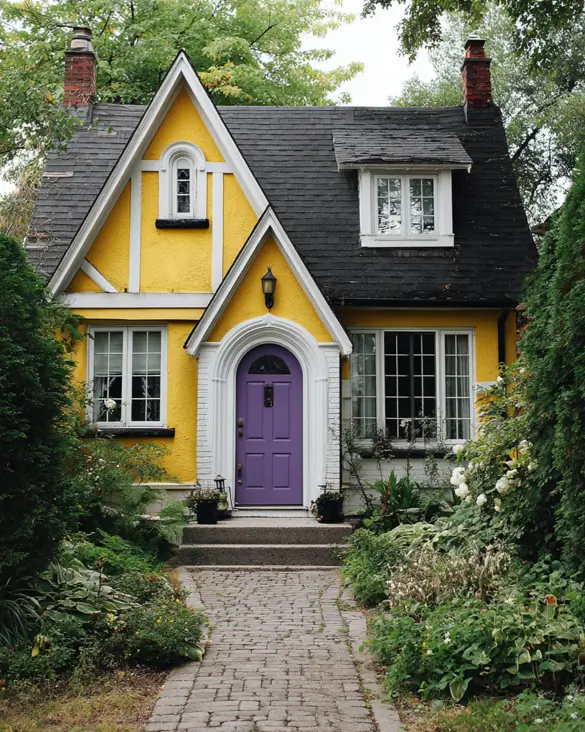
Sunny yellow siding creates an unapologetically cheerful exterior, especially when paired with an equally bold purple front door. Crisp white trim around the arched doorway and windows provides a clean frame that makes the vibrant hues pop.
Design Tip: When using a vibrant exterior color, an equally bold choice for the front door often works well. The white trim here acts as a neutral buffer, allowing both strong colors to shine independently without clashing.
20. Mix Stone and Timber
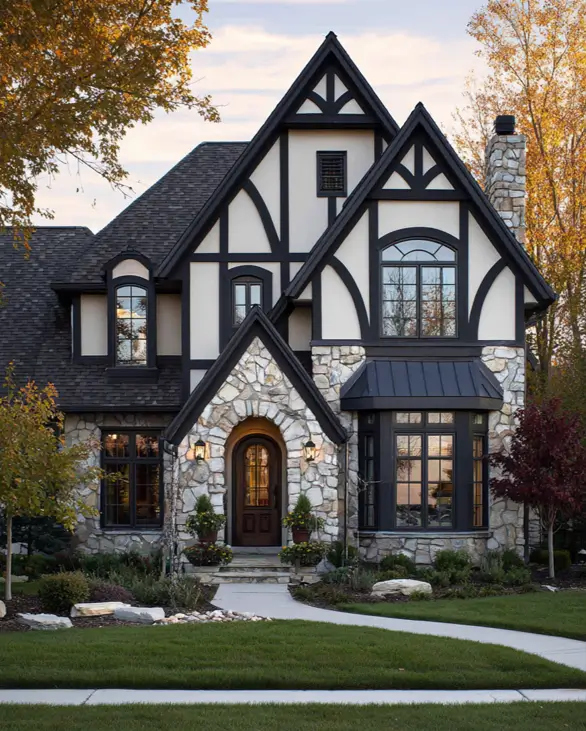
Light-colored fieldstone provides a substantial, textured base for this home, beautifully grounding the crisp stucco and dramatic black timbering. This powerful combination of materials creates a modern interpretation of the Tudor style that feels both grand and impeccably crafted.
Design Tip: For a new Tudor-style home, the scale of the materials is paramount. Large, irregular fieldstones are perfectly balanced by thick, bold timbering. Keeping these key elements in proportion creates a cohesive and authentically grand look.
21. Add an Oak-Framed Entry
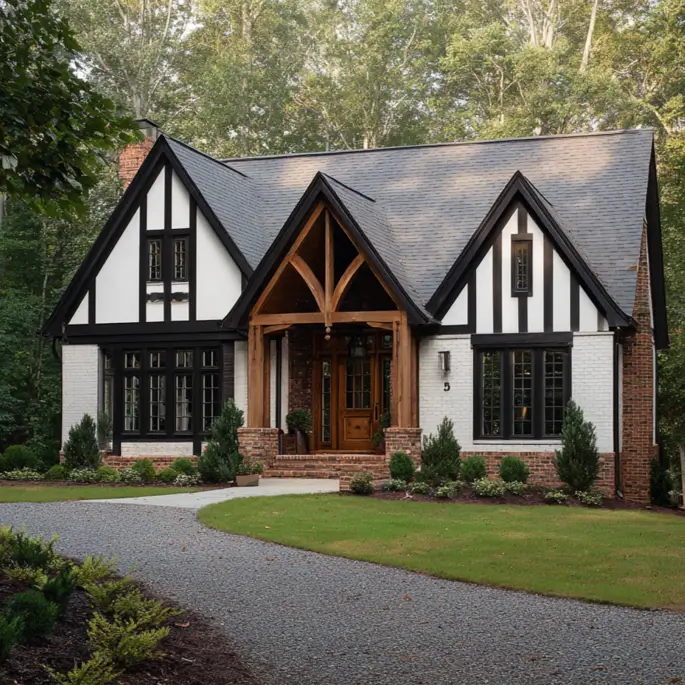
Exposed heavy timber framing on the porch creates a stunning, rustic focal point against the clean lines of the painted white brick. This deliberate contrast between the natural, warm wood and the graphic black-and-white color scheme results in a sophisticated small modern Tudor-style house.
Design Tip: When working with a classic black-and-white exterior, a significant natural wood element acts as a bridge between the stark modern palette and the natural surroundings, adding instant warmth and a bespoke, crafted feel.
22. Anchor with a Stone Entryway
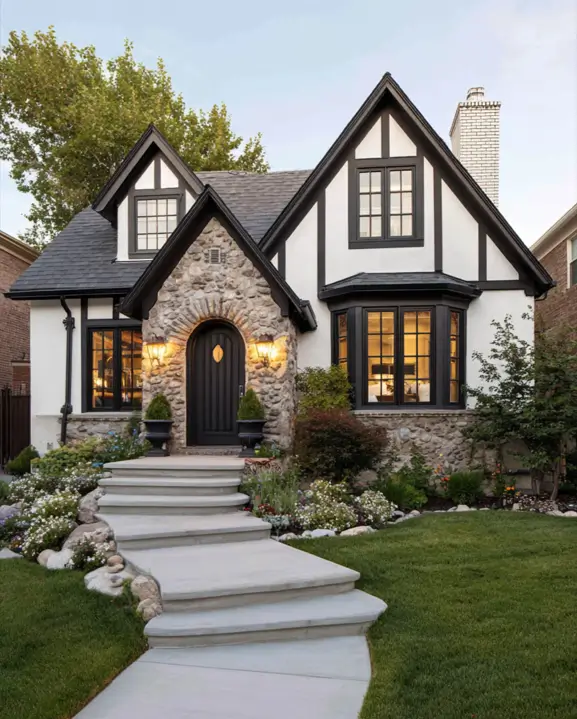
Heavy fieldstone crafts a dramatic arch, creating a powerful and rustic focal point for the entrance. This raw texture provides a beautiful counterpoint to the sharp, graphic quality of the black half-timbering and clean white stucco, resulting in a perfectly balanced and sophisticated design.
Design Tip: A successful strategy for updating a classic home is to mix in modern elements. The smooth, sweeping concrete steps provide a clean, contemporary path that contrasts beautifully with the rustic stonework, signaling an updated interior.
23. Modernize with White and Blue
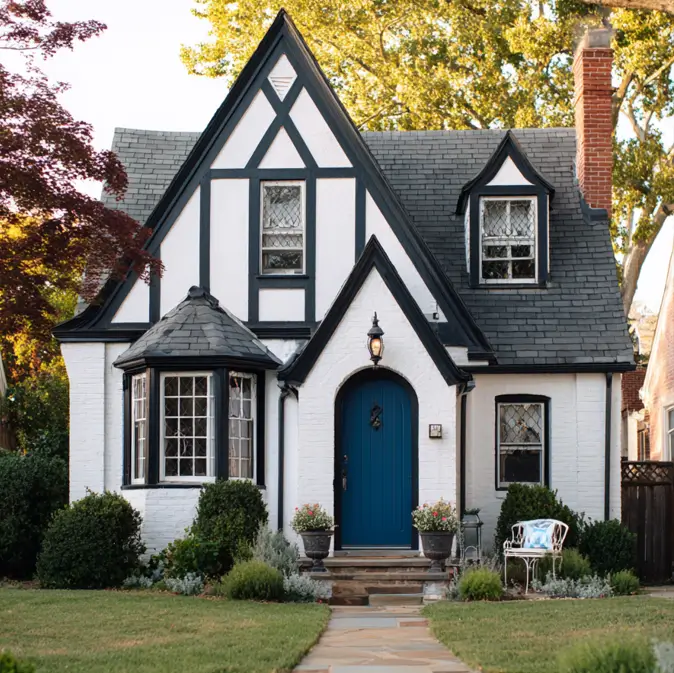
Crisp white-painted brick provides a clean, modern canvas for dramatic black timbering and a bold, cobalt blue door. This confident color choice adds a vibrant splash of personality to the graphic black-and-white scheme, creating an inviting and contemporary entryway.
Design Tip: To update a classic home, a painted brick exterior can work wonders. White maximizes brightness for a high-contrast look that feels fresh, while a slate-gray roof maintains a connection to the home’s historic roots.
24. Create a Modern Lodge Feel
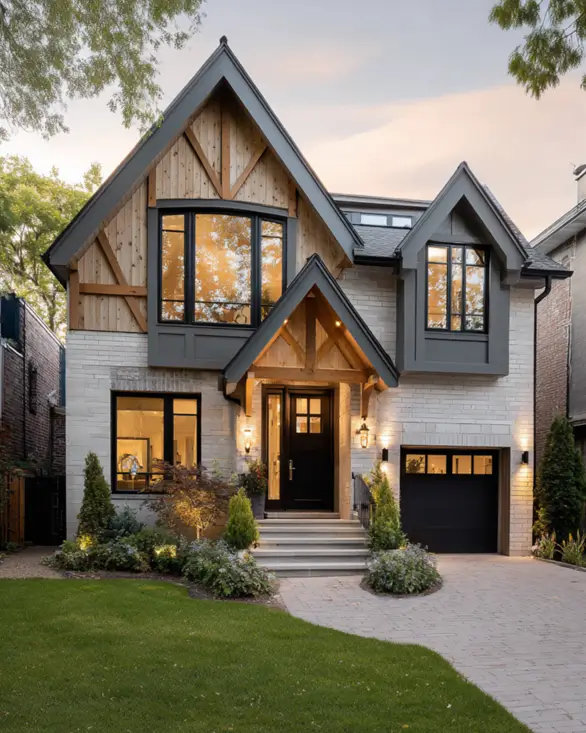
Natural wood siding and light-colored stone create a beautiful textural contrast on this modern home. The design reinterprets classic Tudor gables with expansive black-framed windows and sleek grey accents, successfully blending a rustic, lodge-like warmth with clean, contemporary lines.
Design Tip: When blending multiple strong materials, use a unifying color to tie the design together. The consistent use of dark charcoal on the window frames, porch roof, and garage door here is the key element that creates a cohesive, high-end look.
25. Opt for a Sophisticated Grey
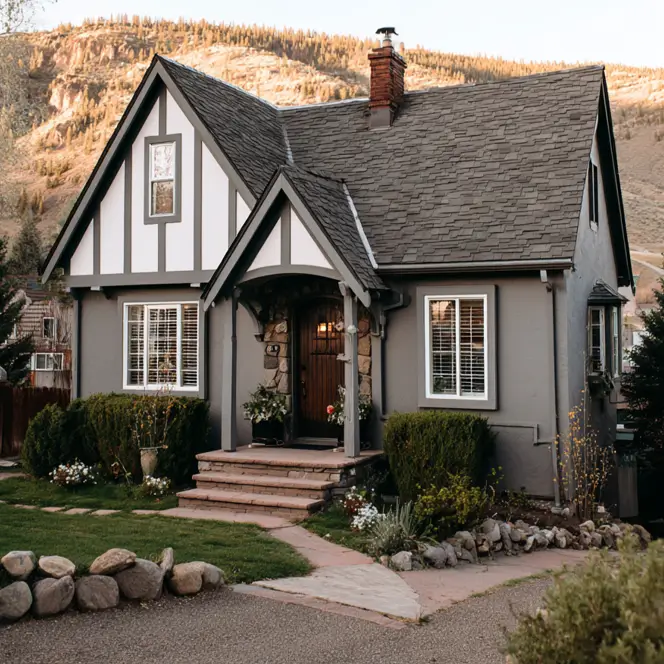
Medium-grey stucco offers a modern yet timeless alternative to traditional white or cream. Paired with light trim, the scheme feels elegant and understated. The warm wood door and rustic stone entry provide a perfect, organic touch that keeps the cool grey from feeling austere.
Design Tip: Grey works beautifully as a ‘new neutral’ for updating a traditional home. It’s softer than a graphic black-and-white scheme but still feels fresh, allowing architectural details to stand out in a more subtle way.
26. Use a Soft, Earthy Palette
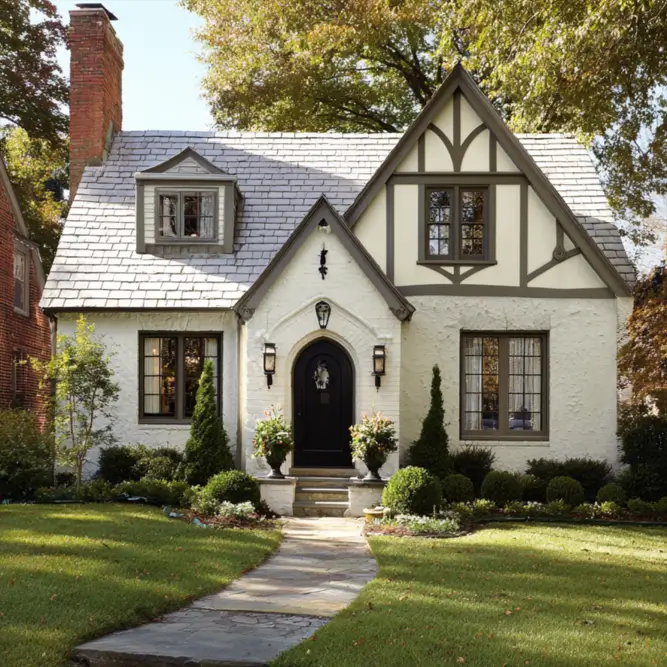
Creamy white painted brick provides a warm and inviting base for this charming cottage. Choosing an earthy taupe for the half-timbering and trim creates a gentle, sophisticated contrast that feels softer and more traditional than a stark black-and-white scheme.
Design Tip: For a timeless look, historical color palettes are an excellent resource. A muted, earthy trim color defines the architectural details beautifully without the high contrast of more modern interpretations.
27. Maximize Drama with Contrast
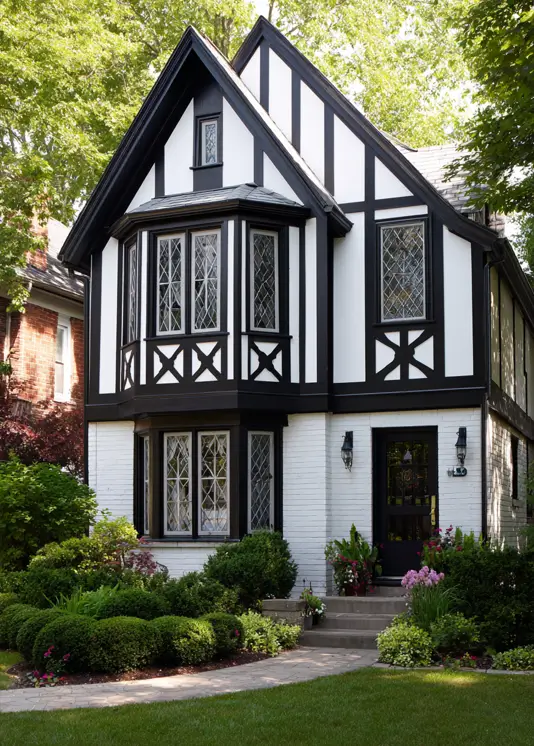
Bold black timbering creates a stunning graphic overlay against the clean, white-painted brick. This timeless combination sharply defines the home’s architectural features, from the dramatic bay window to the intricate leaded glass, resulting in a look that is both commanding and elegant.
Design Tip: When committing to a high-contrast black and white scheme, the window details become essential. The diamond-pane leading here is crucial because it adds an intricate layer that prevents the bold, graphic palette from feeling flat.
28. Choose a Nature-Inspired Green
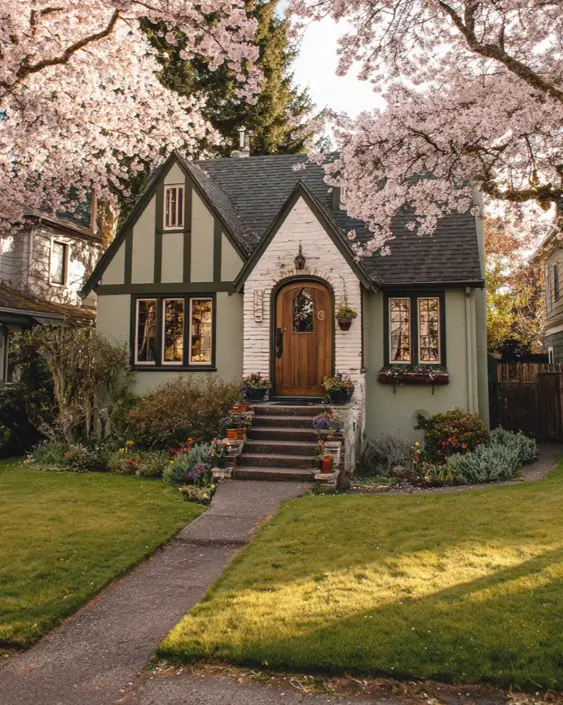
Earthy sage green stucco creates a gentle facade that harmonizes beautifully with the landscape. A clean, white-painted brick surround highlights the arched entryway, providing a bright focal point that contrasts wonderfully with the warm, natural finish of the plank front door.
Design Tip: One thing many find is that the best color inspiration often comes from the garden. A soft green feels so natural because it connects the home to its surroundings. Seasonal elements then become a beautiful, fleeting accent against the home’s permanent palette.
29. Spotlight the Chimney
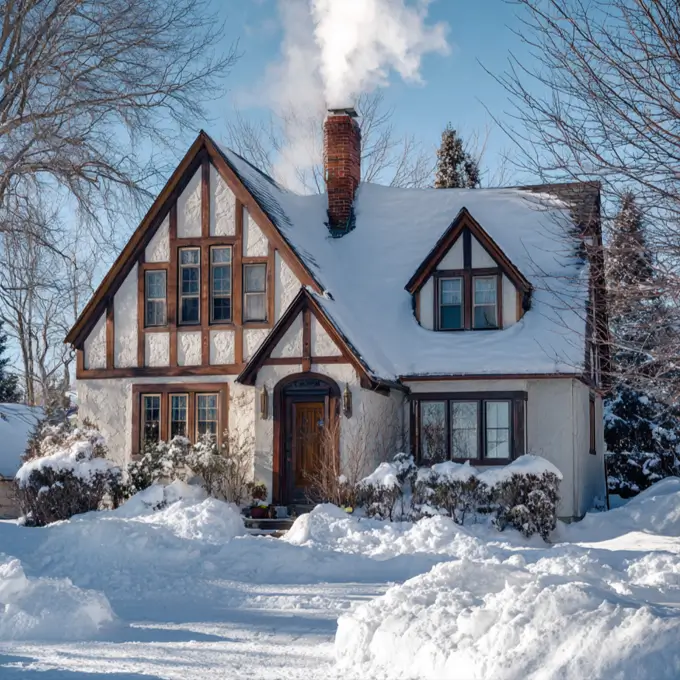
Classic Tudor details like dark timbering and a prominent brick chimney stand out beautifully against a blanket of fresh snow. The warm glow from the windows and smoke curling from the chimney create an undeniable sense of cozy refuge from the cold.
Design Tip: In colder climates, emphasizing the chimney is key to the Tudor aesthetic. Keeping the brick natural provides a warm, earthy element that feels especially welcoming during the winter months.
30. Nestle into a Woodland Setting
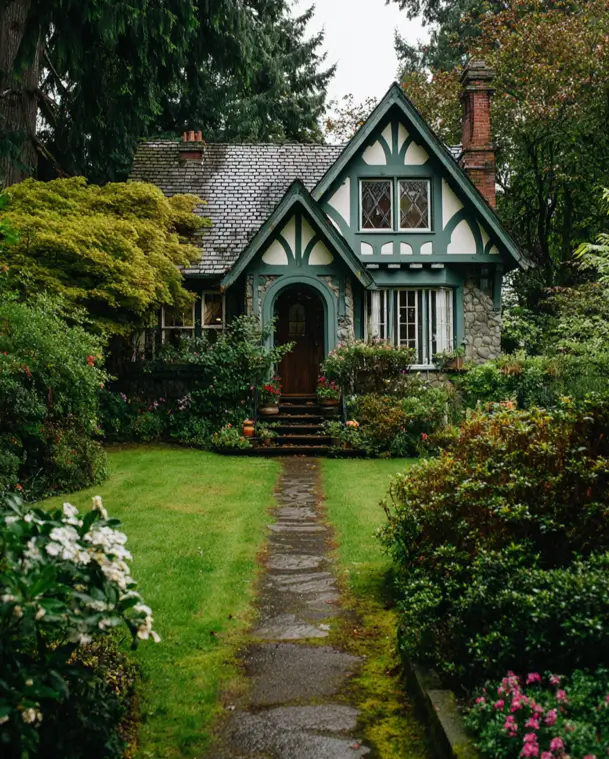
Deep forest-green trim and natural stonework help this cottage blend seamlessly into its woodland surroundings. The structure feels like a natural extension of the lush, romantic garden, creating a truly private and enchanting retreat tucked away among the towering trees.
Design Tip: When a home is surrounded by nature, pulling the color palette directly from the landscape is a proven strategy. Choosing a deep, moody green for the trim allows the house to recede beautifully into the trees, creating a feeling of harmony.
31. Add a Cedar Shake Roof
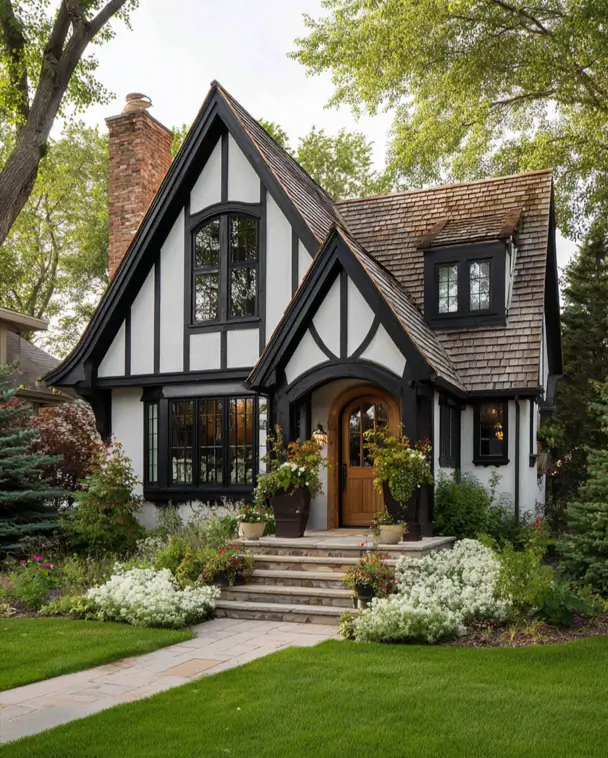
Textured cedar shakes on the roof and a substantial brick chimney lend an authentic, old-world feel to this cottage. The high-contrast black timbering feels sharp and modern, while the warm, rounded wooden door provides a soft and welcoming focal point.
Design Tip: To balance a graphic black-and-white scheme, incorporating natural textures is essential. The warm wood of the door and the varied tones of the cedar shake roof prevent the design from feeling too stark and add layers of visual interest.
32. Add a Deck and Balcony
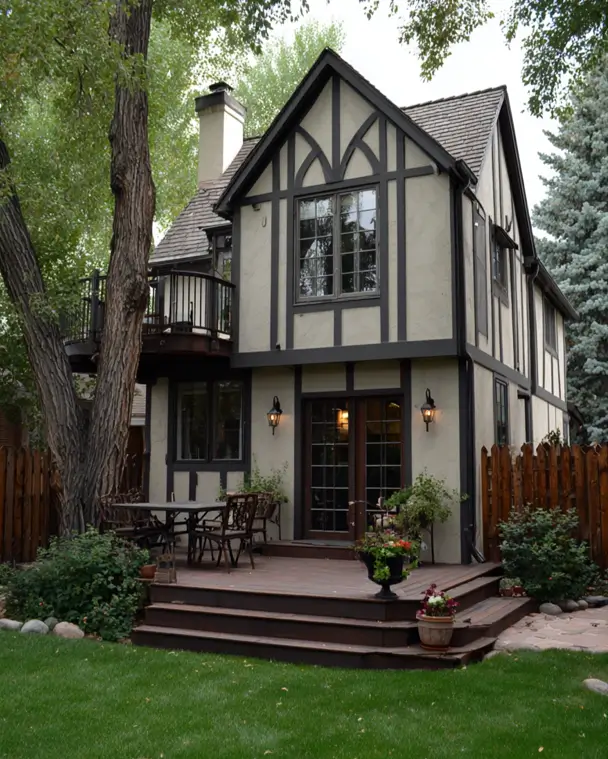
Generous outdoor living spaces, including a large wooden deck and a private second-story balcony, make this home perfect for entertaining. The muted, earthy color scheme of taupe stucco and dark timbering feels sophisticated and connects the structure harmoniously to its natural backyard setting.
Design Tip: Tudor homes aren’t just about the front facade. Functional outdoor rooms at the back, like a multi-level deck or a private balcony, extend the home’s living space and connect it to the garden.
33. Capture Classic Cottage Charm
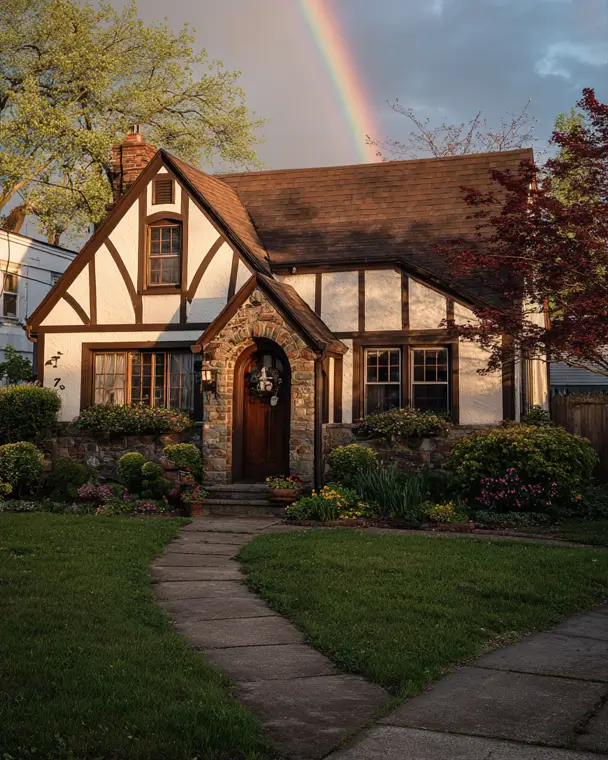
Rustic stonework on the arched entry gives this small Tudor-Style house a timeless, cottage quality. Warm brown timbering against cream stucco creates a soft, classic look, while the established garden and low stone planters enhance the home’s inherent storybook charm.
Design Tip: For a truly timeless look, investing in high-quality, classic materials for the entrance is key. The combination of natural stone, a solid wood door, and traditional light fixtures will always feel authentic and welcoming.
34. Blend Tudor and Farmhouse Styles
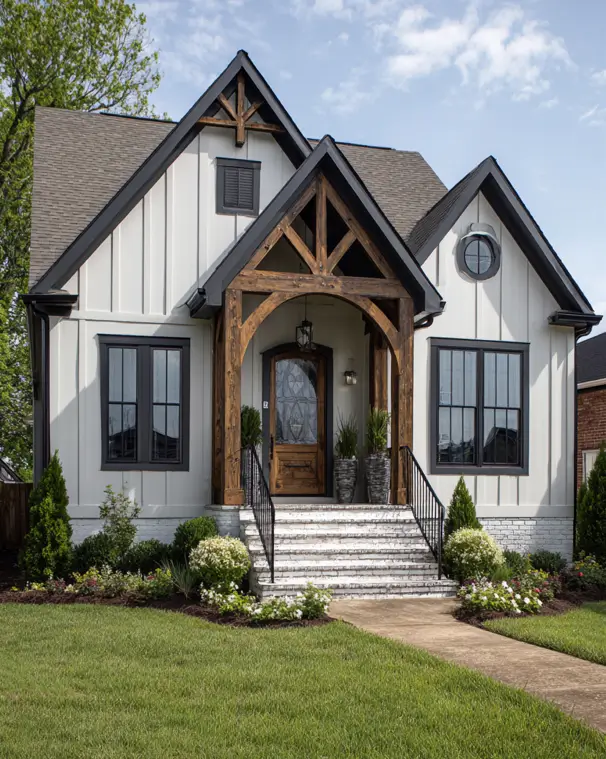
Vertical board-and-batten siding and a crisp white palette give this home a modern farmhouse feel, while the steep gables and heavy timber porch retain a clear Tudor influence. This successful style fusion creates a look that feels both current and timelessly charming.
Design Tip: The key to successfully blending architectural styles is creating a consistent color palette. The strict adherence to white siding, black trim, and natural wood here is what allows the farmhouse and Tudor elements to coexist so beautifully.
35. Create a Moody, Modern Facade
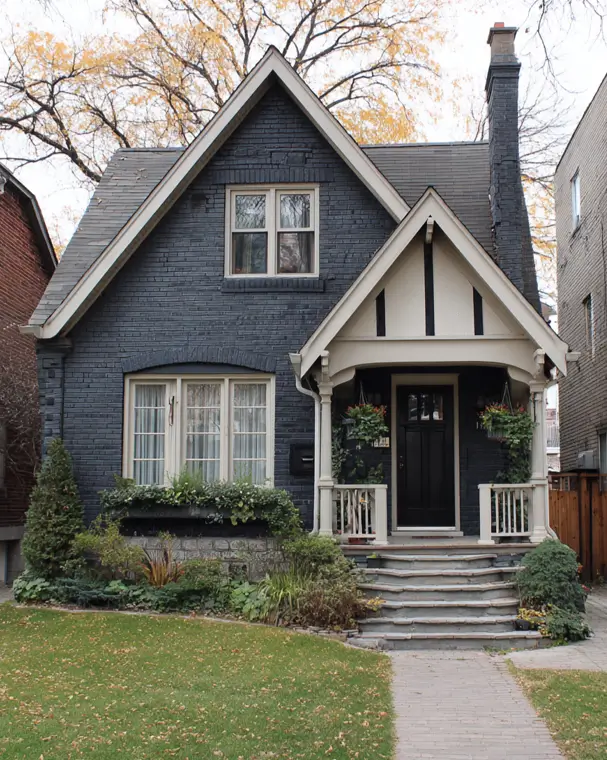
Deep charcoal-painted brick gives this small modern Tudor-style house a bold, contemporary edge. The bright, cream-colored trim in the gabled portico provides a single point of high contrast, drawing immediate attention to the entrance and creating a welcoming focal point.
Design Tip: When opting for a dark exterior, keeping the porch or entryway a lighter, brighter color is a great design strategy. This not only creates a clear destination but also reflects light, making the entrance feel safer and more inviting.
36. Lead with a Brick Walkway
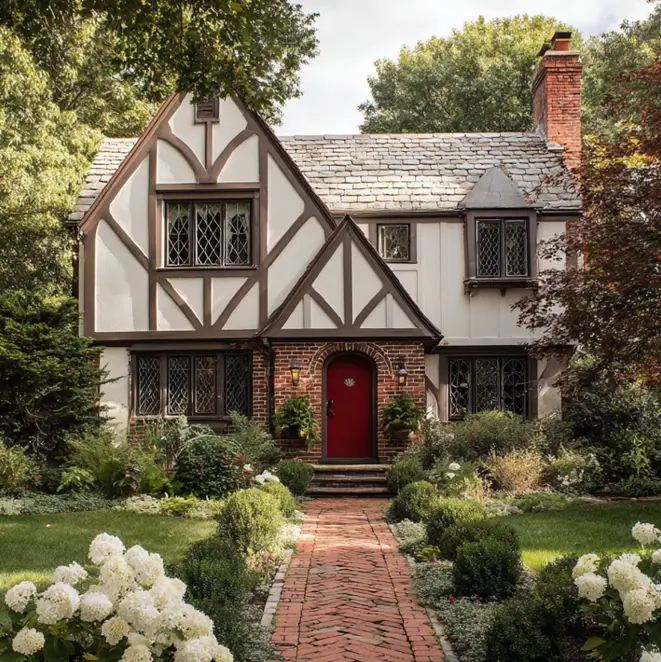
Winding herringbone brick leads the eye to a charming brick entry, perfectly framing a bold red door. Warm brown timbering and diamond-pane windows complete this home’s classic, storybook appeal, creating an inviting and picturesque scene.
Design Tip: A walkway is more than just a path; it’s the first part of the home’s story. Using classic materials like herringbone brick creates a sense of journey and anticipation, guiding guests to the front door with texture and timeless style.
37. Simplify with Monochromatic Stucco
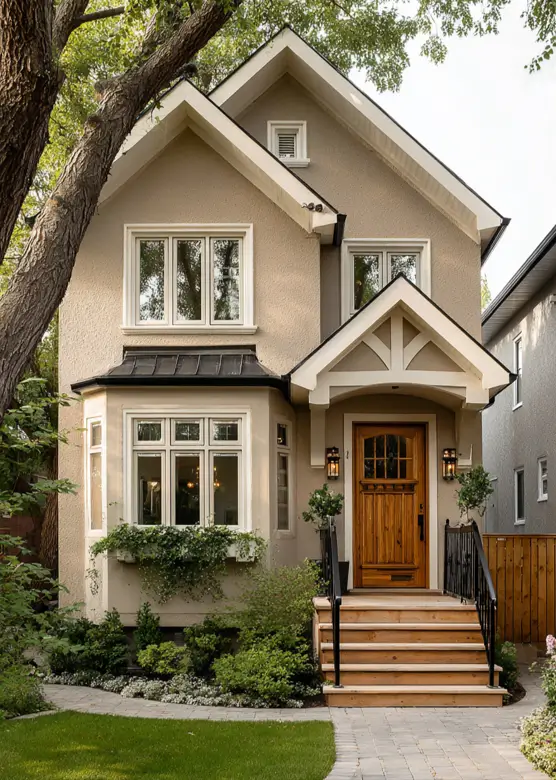
Warm beige stucco creates a clean, monolithic look, simplifying the home’s traditional Tudor gables. Stripping away the classic half-timbering allows the strong architectural form, crisp white trim, and a warm wood door to become the primary design statements for this small Tudor-style house.
Design Tip: For a modern interpretation of the Tudor, simplifying the material palette is very effective. By forgoing traditional timbering and using a single stucco color, the focus is placed squarely on the home’s beautiful silhouette and rooflines.
38. Curate an Elegant Facade
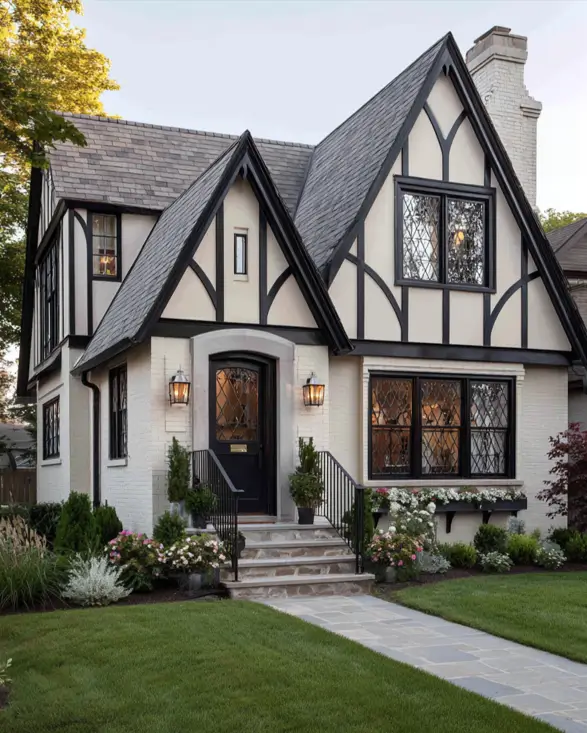
Crisp white-painted brick serves as the perfect canvas for the elegant, curving lines of the black half-timbering. Intricate diamond-pane windows are framed like works of art, adding to the home’s sophisticated and timeless character, while a slate roof provides a final touch of quality.
Design Tip: The windows should be treated as a key decorative element in a Tudor design. By painting the window frames the same dark color as the timbering, a cohesive visual language is created that makes the entire facade feel thoughtfully designed.
39. Create an Enchanted Cottage
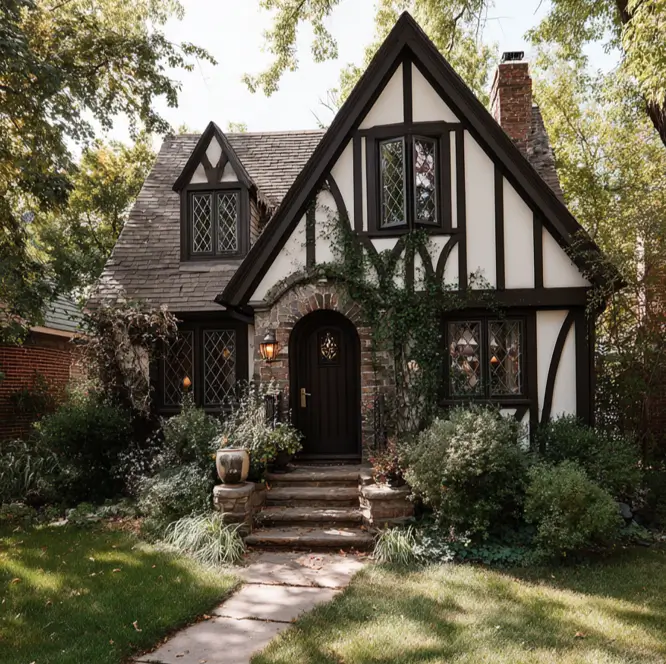
Dark brown timbering and a heavy stone archway give this cottage a rich, historic character. Nestled among mature trees and surrounded by a lush garden, the home feels like a private, enchanted retreat, beautifully integrated with its natural, wooded environment.
Design Tip: Letting the landscaping around a Tudor cottage be a bit untamed often enhances its appeal. Allowing greenery to creep up the walls and letting shrubs grow full creates a soft, romantic look that enhances the home’s inherent storybook quality.
40. Go Bold with Blue Stucco
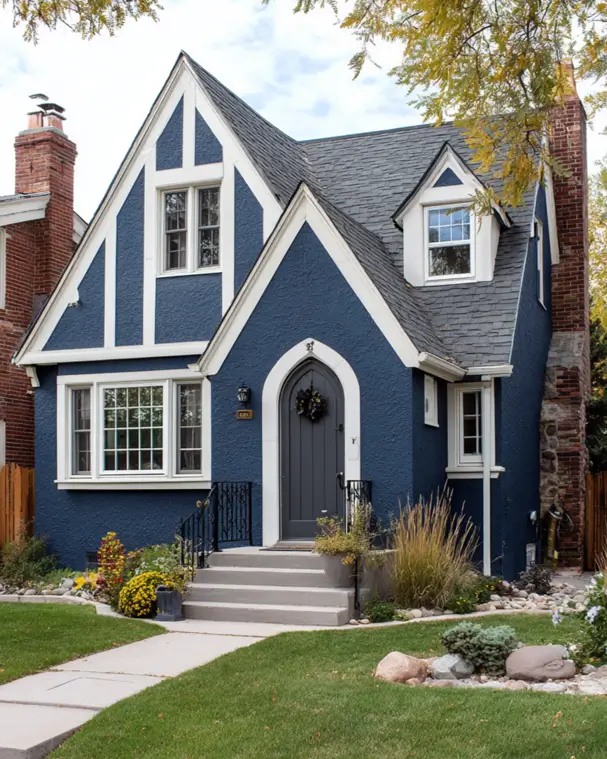
Deep blue stucco gives this home a bold and contemporary personality. Bright white trim sharply outlines the steep gables and arched entry, creating a clean, graphic look that highlights the home’s strong architectural lines and modern Tudor character.
Design Tip: Using a single, saturated color on a textured surface like stucco can be incredibly impactful. It unifies the facade and provides a modern backdrop that makes traditional details, like the simplified half-timbering, feel fresh and intentional.
41. Add Craftsman Influence
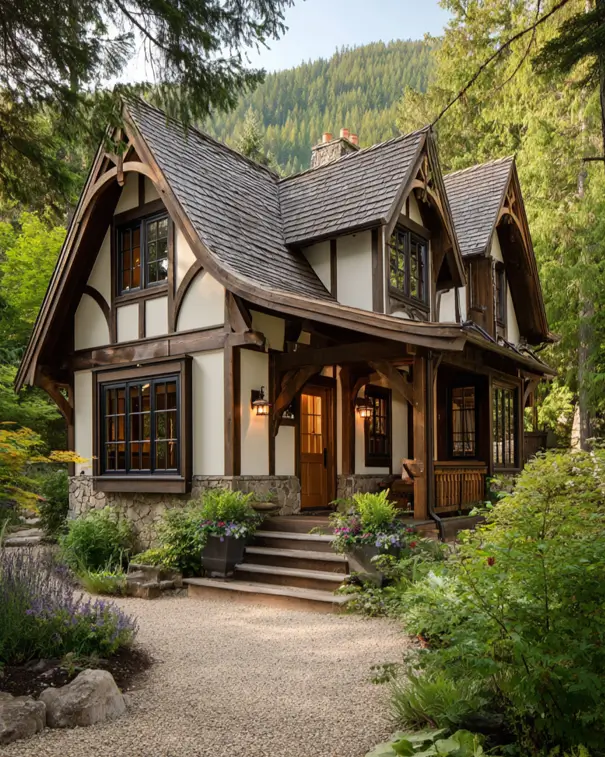
Heavy timber framing with exposed joinery brings a strong Arts and Crafts feel to this woodland retreat. The design beautifully combines a rustic stone base, warm wood trim, and a textured shake roof, creating a home that feels hand-built and deeply connected to its natural surroundings, a core principle of the historic design movement.
Design Tip: When designing for a wooded lot, prioritizing natural materials that echo the environment is a reliable approach. The combination of stone and heavy timber not only feels appropriate for the setting but also creates a sense of permanence and authentic charm.
42. Mix in Wood Cladding
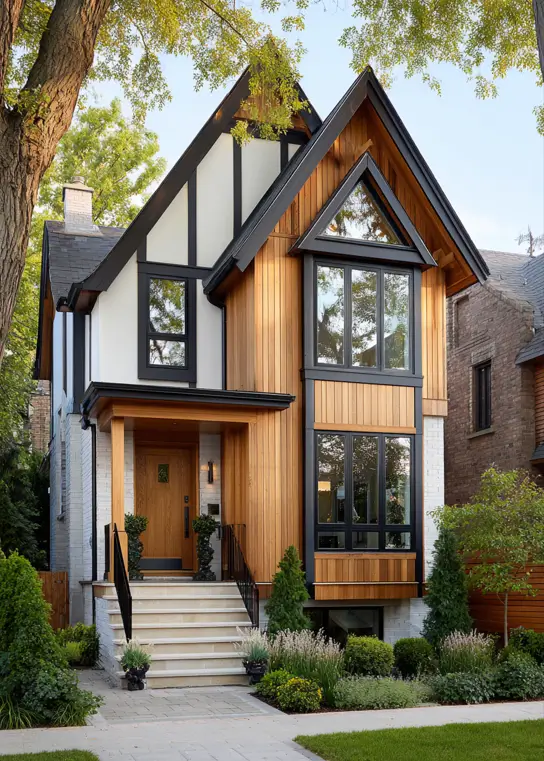
Warm wood cladding creates a striking, modern focal point on the home’s prominent front gable. This natural texture is beautifully juxtaposed with classic Tudor half-timbering and clean white brick, while bold black trim ties the diverse materials together into a single, cohesive design.
Design Tip: Mixing materials on a modern Tudor can yield stunning results. Using a large section of a warm element like wood to break up the traditional stucco or brick creates a dynamic, contemporary facade while still honoring the home’s classic gabled silhouette.
43. Feature a Character-Rich Door
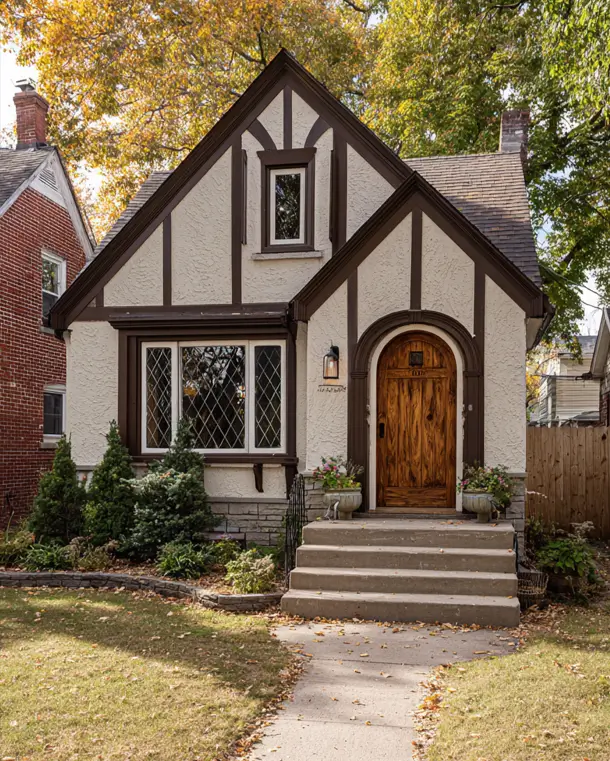
Warm brown timbering and textured stucco create a classic cottage backdrop. The true focal point is the stunning wood-grain door, its rounded top and rich finish adding immense character and a bespoke, handcrafted feel. Exploring different Tudor front door styles is one of the most impactful parts of an exterior makeover.
Design Tip: On a smaller home, investing in a high-quality, character-grade wood door delivers a huge impact. The natural grain and texture provide a level of detail and warmth that makes the entire entrance feel more substantial and inviting.
44. Add Decorative Gothic Flair
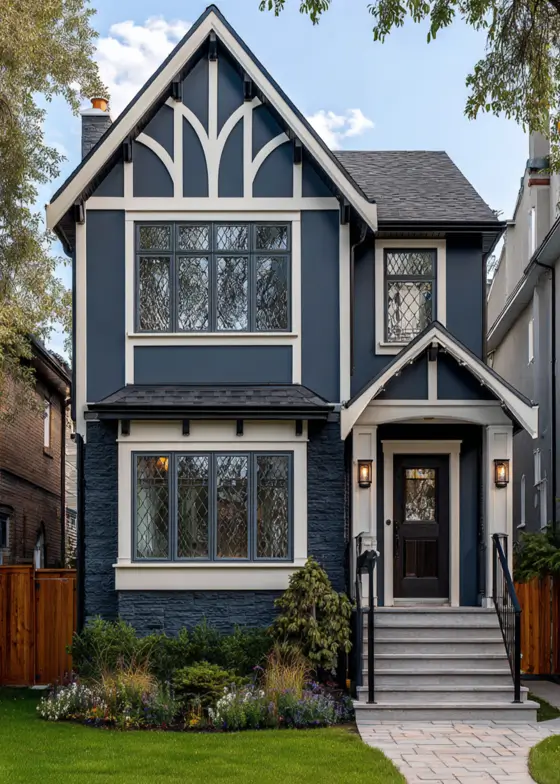
Inky blue siding and matching textured stone create a dramatic, modern foundation. Decorative, Gothic-inspired timbering in the main gable provides a beautiful, custom flourish. This detail, combined with leaded glass windows, gives the home a sophisticated and distinctly elegant personality.
Design Tip: Half-timbering doesn’t have to be limited to simple straight lines. Incorporating curves and Gothic shapes, especially in the main gable, is a way to add a bespoke, artistic detail that makes a build feel instantly special.
45. Refine with an Elegant Palette
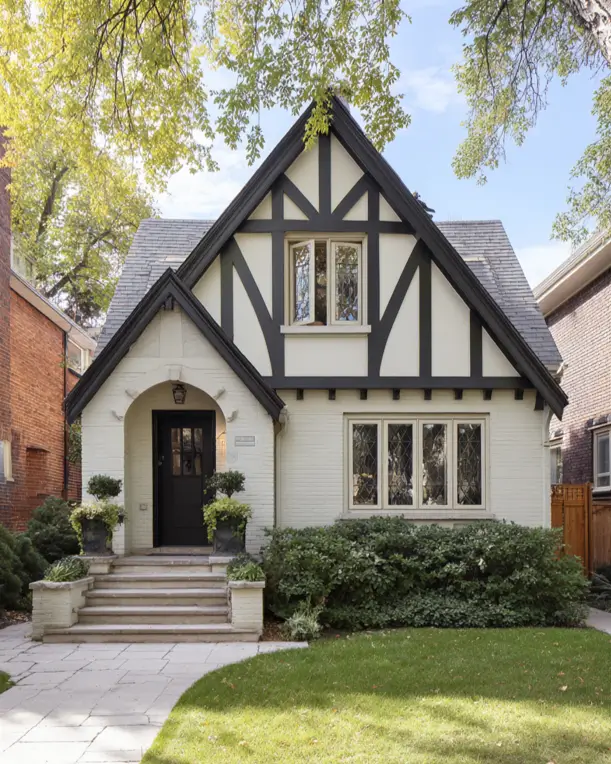
Creamy painted brick offers a warm, soft backdrop for the graphic black timbering in the gable. A simple, light-stone arch elegantly frames the entryway, creating a refined focal point. This carefully curated combination results in a polished, sophisticated look that feels both classic and fresh.
Design Tip: The texture of the primary material sets the tone. A smooth painted brick finish creates a more formal and refined look than can be achieved with textured stucco, allowing the clean lines of the architecture to take center stage.
46. Add a Playful, Colorful Door
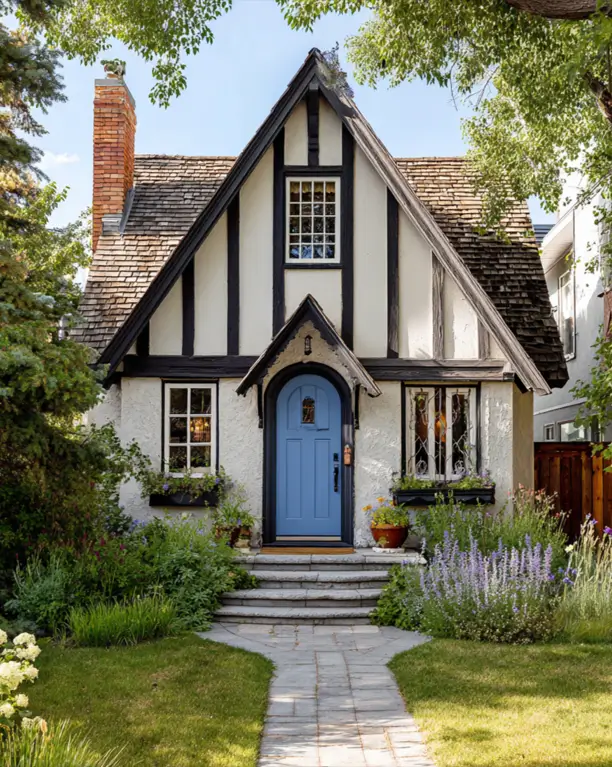
Charming periwinkle blue on the front door provides a delightful splash of personality against this cottage’s classic black-and-white facade. Simple timbering, a textured cedar shake roof, and a lush cottage garden complete the idyllic, storybook scene.
Design Tip: The front door is the perfect place to introduce a playful, personal color without a full exterior repaint. Against a neutral backdrop, a splash of a favorite hue, from soft pastels to bold primary colors, always feels like a confident and welcoming choice.
47. Emphasize Authentic Craftsmanship
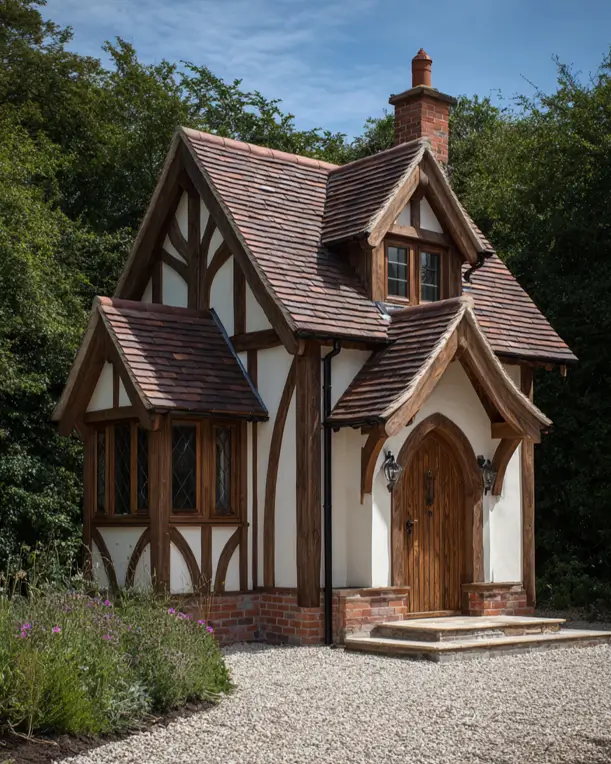
Natural oak timbering and a terracotta tile roof give this cottage an authentic, handcrafted feel. A low brick base grounds the structure, while the magnificent arched wooden door and traditional lanterns complete the look of a timeless, storybook retreat.
Design Tip: What truly sets a successful new-build Tudor apart is the commitment to authentic materials. Real wood, clay tiles, and traditional brickwork create a sense of history and quality that simply cannot be replicated with synthetic substitutes.
Final Thoughts on Designing Your Small Tudor Home
The small Tudor-style house’s enduring appeal lies in its remarkable versatility, blending rustic charm with modern taste. Whether planning a complete Tudor exterior makeover or a simple color update, honoring the inherent character of your small Tudor home is the key to creating a space that is uniquely your own.
Frequently Asked Questions
What are the key features of a small Tudor-style house?
A small Tudor home is most recognizable by its steeply pitched roof, often with multiple overlapping gables. Other key features of this architectural style include decorative half-timbering, prominent brick or stone chimneys, and tall, narrow windows, frequently with diamond-shaped panes.
How do you update a small Tudor exterior?
Updating a Tudor exterior often involves simplifying the color schemes. Painting the brick and stucco a crisp white, deep charcoal, or a monochromatic blue can create a stunning small modern Tudor-style house. Swapping traditional light fixtures for more streamlined designs and simplifying the landscaping are also popular updates that make a big impact.
What colors work best on a Tudor home?
For a classic look, a high-contrast palette of dark brown or black timbering against a cream or white stucco is timeless. For a more modern or softer feel, exterior color schemes using earthy greens, moody blues, or sophisticated greys work beautifully. A bold, unexpected color on the front door is always a great way to add personal flair.
What landscaping works best for a small Tudor home?
Excellent Tudor landscaping ideas often complement the home’s storybook quality. For a formal look, structured boxwood hedges and classic roses are perfect. For a more relaxed feel, an English cottage design with a mix of colorful, layered perennials and climbing vines perfectly complements the romantic architecture.
What is the difference between a Tudor and a cottage?
While many small Tudor homes have a cozy cottage feel, “Tudor” refers to a specific architectural style with features like half-timbering and steep gables. “Cottage” is a broader term describing a small, charming house, which can be built

